Posts Tagged ‘smart on crime’
Posted on: November 23rd, 2016 by Waterloo Region Crime Prevention Council
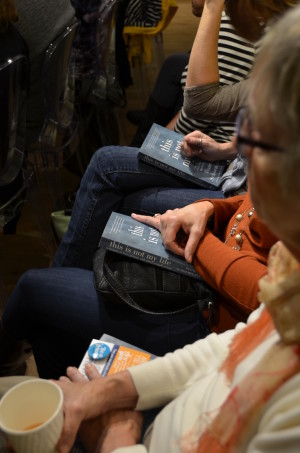 All of the calls to action already mentioned in the previous blog posts (humanizing people in prison & advocating for programs that work) help to create and strengthen system change in big and small ways. The work of larger structural change is long term, often slow work: Not for the faint of heart, but everyone can still play a role.
All of the calls to action already mentioned in the previous blog posts (humanizing people in prison & advocating for programs that work) help to create and strengthen system change in big and small ways. The work of larger structural change is long term, often slow work: Not for the faint of heart, but everyone can still play a role.
Here are a few ways you or your friends can contribute toward society and system changes.
- Male Allies Against Sexual Violence – Through public education, the Male Allies program invites men and boys to be leaders in the work of ending gender-based violence. Their goal is to encourage critical introspection in men and boys, which begins by helping them to understand gender-based violence as a men’s issue. Over the past eight years, they have offered hundreds of workshops to thousands of men and boys and have just started a ground-breaking training initiative with the Ontario Hockey League.
- Learn more about the root causes of crime. In order to prevent something, it’s important to understand the contributing factors. As a community, we have the responsibility to address these conditions which hinder healthy development and can lead to criminal behaviour.
- Learn more about Smart on Crime approaches to addressing crime. Everyone has heard about tough on crime, but what about Smart on Crime? As a community, we can use language that shows we can build a community that is safe and vibrant for all people living in Waterloo Region.
- Follow the advocacy work of Howard Sapers – Until recently, Howard Sapers was the Correctional Investigator of Canada responsible for the investigation of individual and systemic concerns. He was also a guest for a 2015 Friends of Crime Prevention event. On November 8, the Ontario Government appointed Mr. Sapers to be an independent advisor on corrections reform and to provide advice to the government on the use of segregation and ways to improve the province’s adult corrections system.
When we have people and community organizations working at all three areas of action to humanize people in prison and reduce stigma for loved ones, advocate for programs that work and enter into deeper levels of system and societal change, we can move the needle on progressive change.
If you decide to take some action, we would love to hear about it – 6 weeks from now, or 6 months from now! Get in touch with Juanita Metzger to share your story.
Posted on: November 23rd, 2016 by Waterloo Region Crime Prevention Council
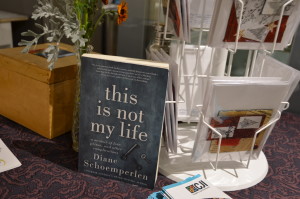 Inevitably, the Turn the Page book club discussions turned to the support provided to people in prison while they serve their sentences and the programs and support available during parole or upon release. Many people in attendance admitted to not knowing the reality facing people on the ‘inside’.
Inevitably, the Turn the Page book club discussions turned to the support provided to people in prison while they serve their sentences and the programs and support available during parole or upon release. Many people in attendance admitted to not knowing the reality facing people on the ‘inside’.
The past 5-7 years have seen a cut in federal funding to several prison support programs (inside and outside prisons) that have shown to be effective in reducing recidivism, building skills for reintegration and providing support to some of the most stigmatized prisoners, people who have sexually offended.
You might be interested in supporting these programs with a donation to keep them going. Or, as someone suggested at the book club event, you might want to write a letter to your Member of Parliament advocating for increased funding to support these valuable programs.
- Lifeline provides support and transitional housing to men who have served a life sentence as they prepare for reintegration into our communities. Funding for this program was cut in 2012/2013. Some Lifeline programs are still offered through various St. Leonard Society organizations.
- Circles of Support and Accountability is a Canadian-made restorative justice program for men and women who have committed serious sexual offences. CoSA allows the community to play a direct role in the restoration, reintegration, and risk management of people who are often seen with only fear and anger. COSA experienced the same severe federal funding cuts as Lifeline in 2014 and has spent a great deal of time figuring out how to support a nation-wide program of COSA chapters. They have even some sample letters already prepared which you could use to advocate for reinstated funding for COSA.
- Prison farms have been a part of 6 federal prison institutions since the establishment of correctional facilities in Canada. They were defunded and closed by the federal government between 2009 – 2013. Prison farms provided beneficial employability and training opportunities, time management and responsibility skills, animal therapy, productive labour and physical exercise, access to nature, individual and team building work, and training in farm management and operation. There are many advocating for the return of prison farms as a prosocial training opportunity for inmates. Project Soil published an excellent case study of the prison farms at Frontenac and Pittsburgh Institutions, both Correctional Services of Canada facilities in Ontario.
- Here is a 59 minute film about prison farms in Canada – Til the Cows Come Home.
If you’re super keen, someone suggested having a letter writing party – invite your friends, invite your neighbours!
There are certainly more prisoner support programs that are proven to work, but these three were discussion specifically at the event.
Also check out the call to action for opportunities to be involved in systems and societal changes.
Posted on: November 23rd, 2016 by Waterloo Region Crime Prevention Council
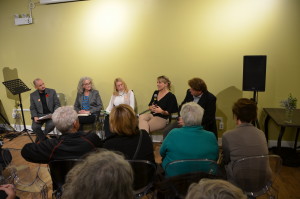 The Turn the Page book club stimulated a great deal of discussion about the stigma. Society, in general, has a negative stigma against people that have been in prison and often their family member and children too.
The Turn the Page book club stimulated a great deal of discussion about the stigma. Society, in general, has a negative stigma against people that have been in prison and often their family member and children too.
People began to ask questions: How do we change this attitude in society and within ourselves? Given that we have a federal prison for women right here in Waterloo Region, how can we help within our own community? How can we get involved?
We’ve pulled together a range of potential ‘calls to action’ that help to humanize people in prison & reduce the stigma of loved ones. As Diane and the panelists reminded us, people in prison will leave prison when their sentences end and return to our communities. Reintegration to life on the ‘outside’ doesn’t happen by magic.
There are countless ways to be involved, likely more than we have to share, but here’s a start.
To start.. Read the Book! If you didn’t get a chance the first time around, it’s still available to borrow at KPL, WPL and Cambridge or get it for sale at Wordsworth Books in Waterloo. We developed a reading guide that might be helpful for checking some of your assumptions and thinking broadly about this issues Diane challenges us with.
If you have a book club, get them to read the book too! We’ve even created a handy Reading Guide to accompany the book.
One of the best ways to start in this area is to work directly with or support the organizations that work with inmates and their families.
- STRIDE is a program of Community Justice Initiatives. STRIDE helps women in prison build informal networks of support that assist them as they reintegrate back to the community. They also prepare the community to receive them safely and supportively. CJI has several other programs that offer support to offenders.
- John Howard Society Waterloo-Wellington offers diverse prevention, diversion, intervention and educational services for children, youth and adults who are in conflict with the law or at risk of getting there.
- Elizabeth Fry Society for Kitchener Waterloo provides gender-specific services, support and advocacy for women within the community, involved in a judicial process or who are serving sentences at Grand Valley Institution for Women, a federal prison for women located in Kitchener.
- Volunteer at Grand Valley Institution – The Correctional Service of Canada has a volunteer program that works directly with recreational activities, classroom and workshop instruction, and cultural or chaplaincy activities and supports families of offenders or helping released offenders re-adjust to life.
These are all very different volunteer opportunities and if you are very interested, best to do the research and find the best fit for you and your interests. You might discover that you prefer a community based approach rather than a formal institutional setting.
Check out the ‘calls to action’ related to advocating for programs that work and creating system change.
Posted on: November 16th, 2016 by Waterloo Region Crime Prevention Council
When you host a public book club, you just never know how things will unfold, much less when you host one with the title “Prisons, Justice and Love”! But we couldn’t have had a more engaging night if we had tried!
Friends of Crime Prevention were pleased to host the first ever “Turn the Page” Book Club with Diane Schoemperlen in November 2016. Scroll through the photos below for a short photo essay of the evening together with community partners, neighbours and Friends.
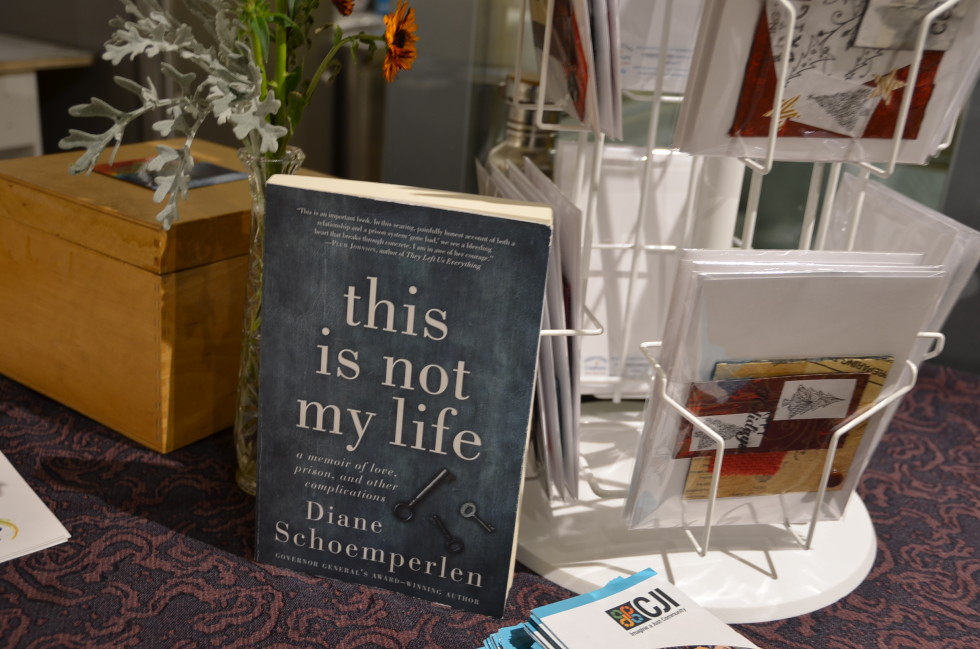
This is not my life by Diane Schoemperlen – our first book club selection for the Turn the Page Book Club focused on prisons, justice and love. A very entangled combination!
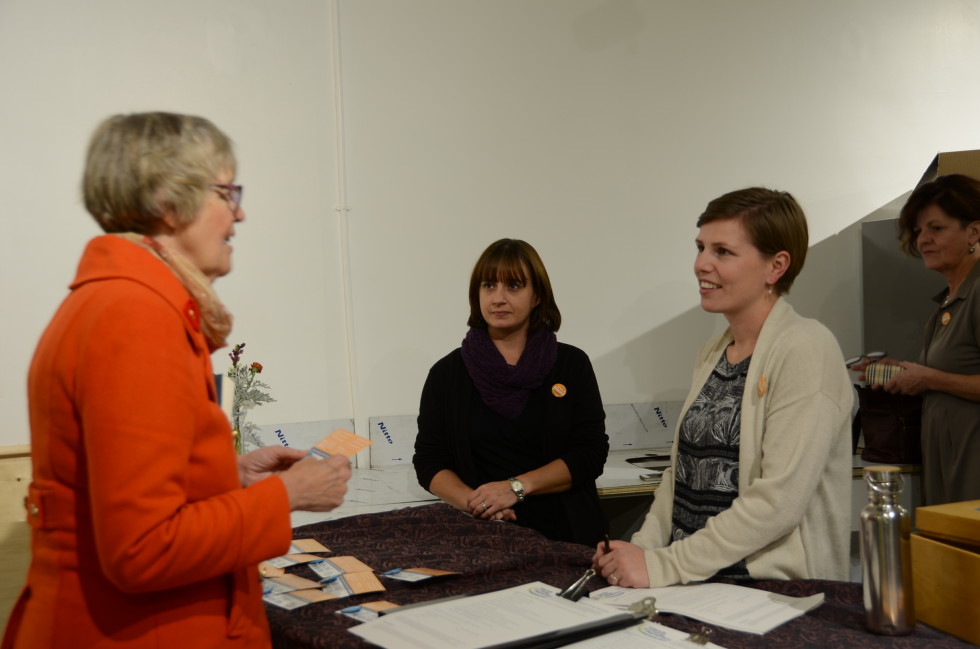
Friends of Crime Prevention, Jenn Robinson (middle) and Lisa Armstrong (right) were the most friendly greeters! Great to see so many new faces.
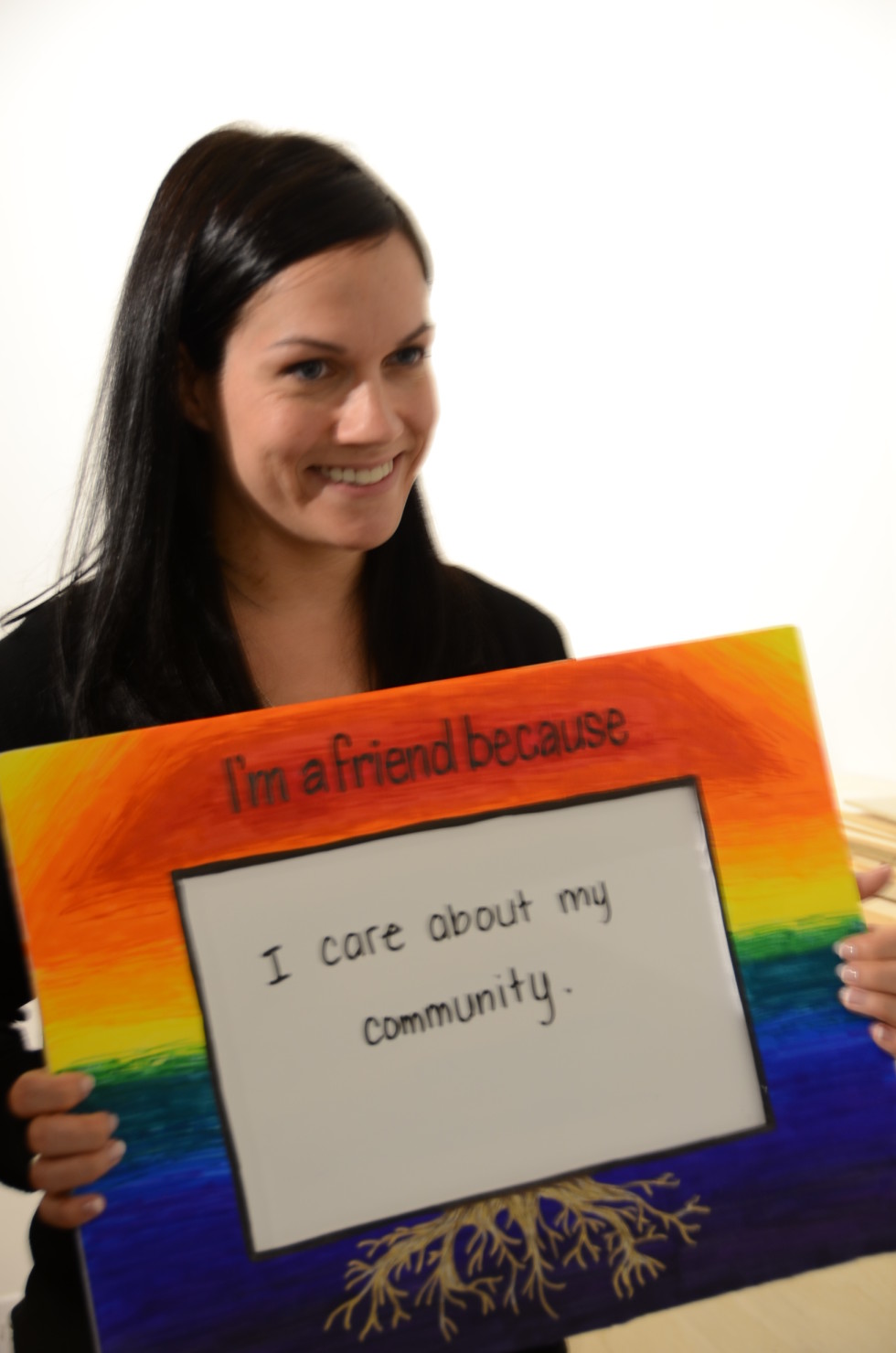
As people gathered for the evening, Friends of Crime Prevention had the opportunity to let us know why they are a Friend. Jeanean Thomas – because I care about my community
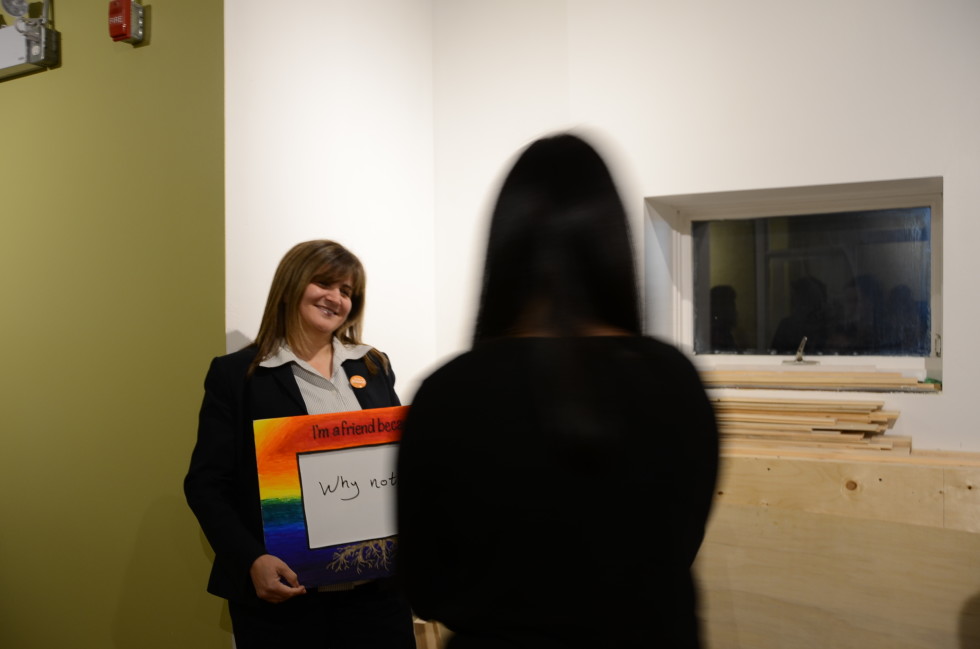
As people gathered for the evening, Friends of Crime Prevention had the opportunity to let us know why they are a Friend.
Pari Karem – Why not?!
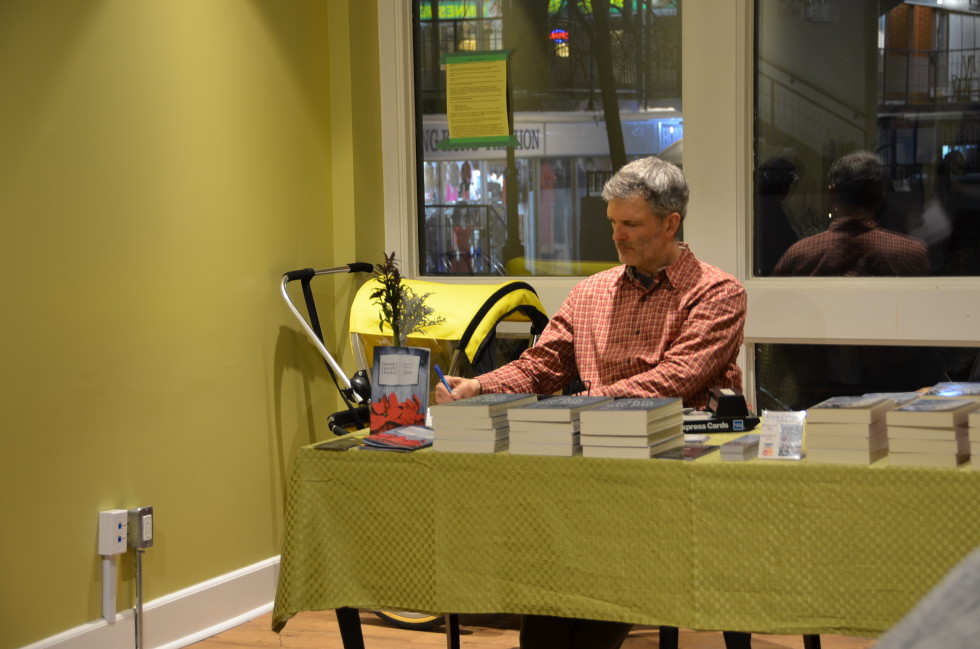
Thanks to John and Wordsworth Books for bringing extra copies of Diane’s book for sale!
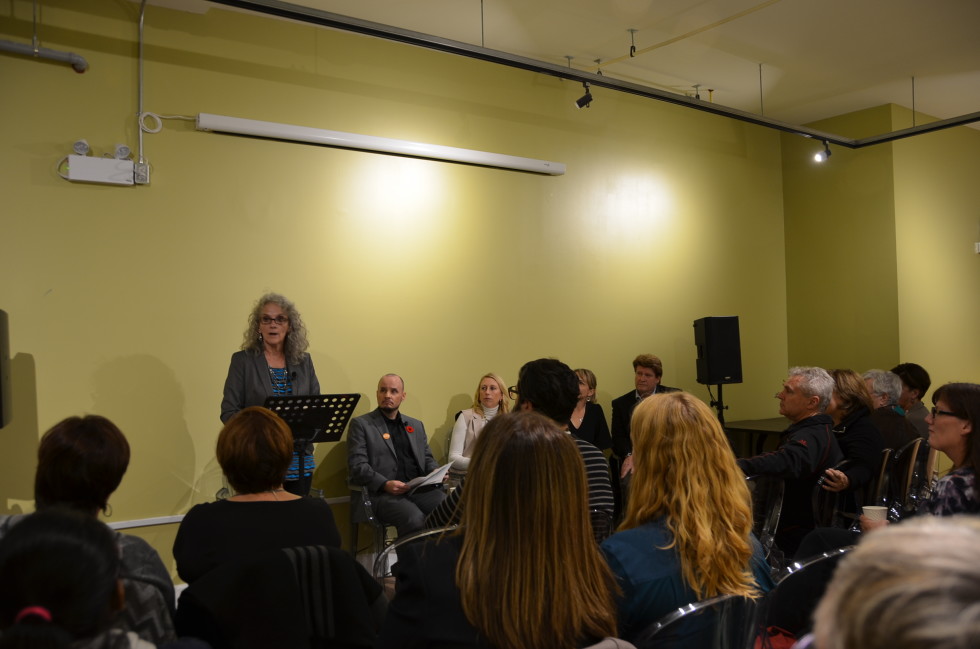
The inaugural Turn the Page Book Club was held at Fresh Ground, a new cafe & community space developed by The Working Centre.
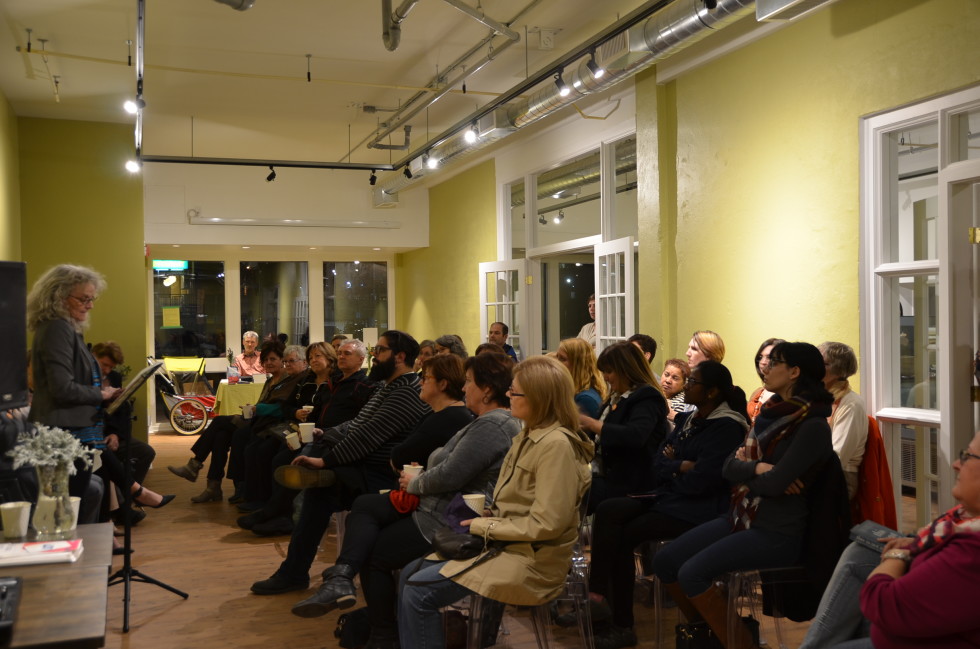
48 people gather to hear Diane read from her new book “This is Not My Life: A Memoir of Love, Prison, and other Complications.
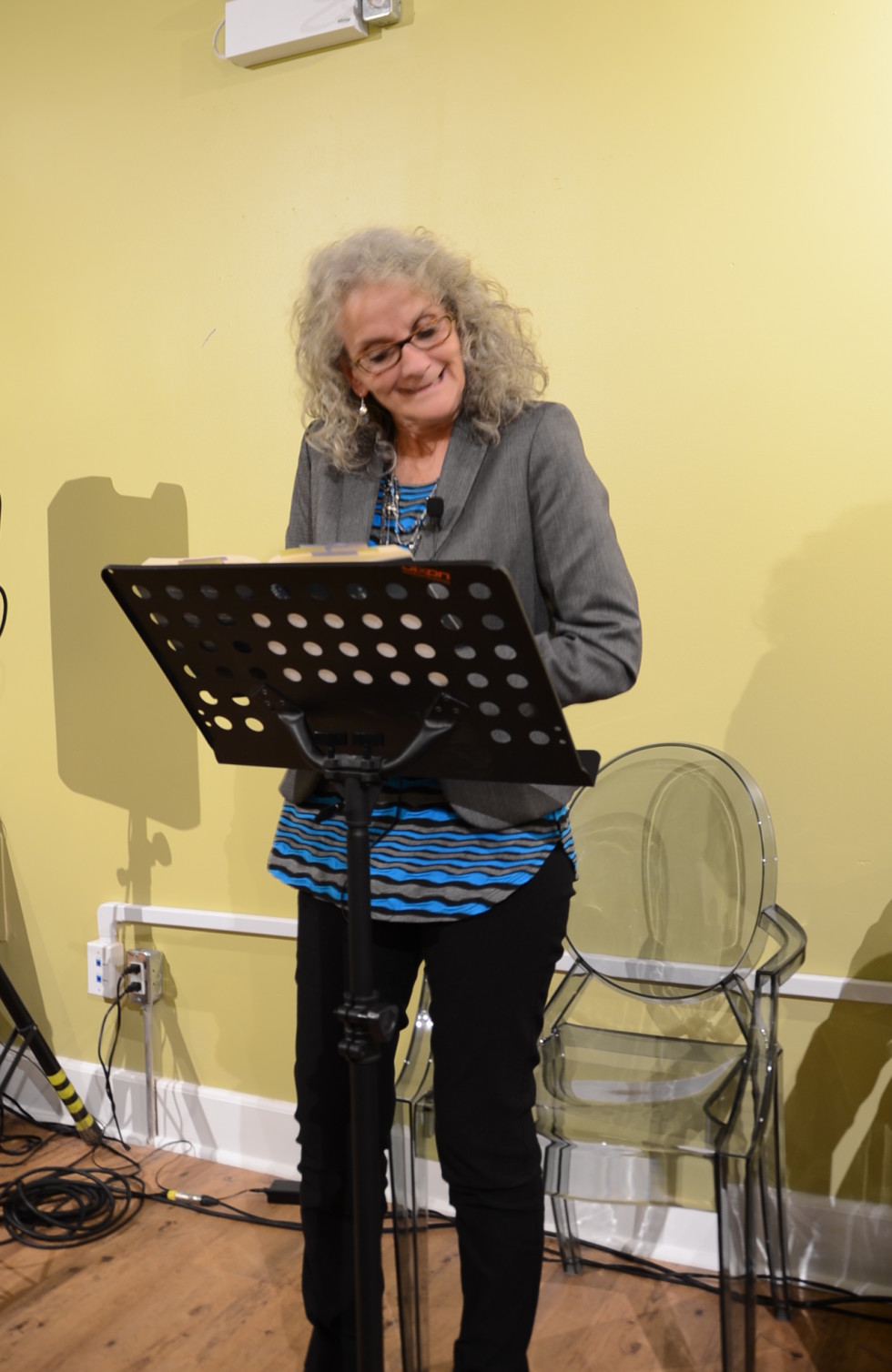
Diane reads the first line of the her book, a first line she is quite proud of! You’ll have to read the book to find out why this line still makes her laugh! Or listen to her interview with The Current on CBC Radio where the host reads it out loud.
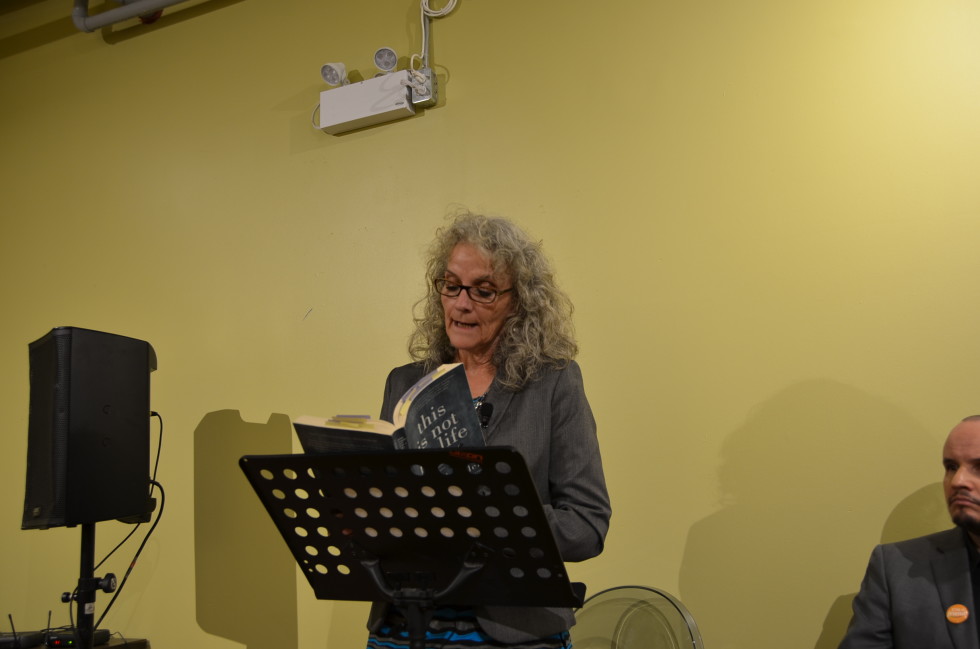
Diane reading some of the more emotionally challenging parts from her book.
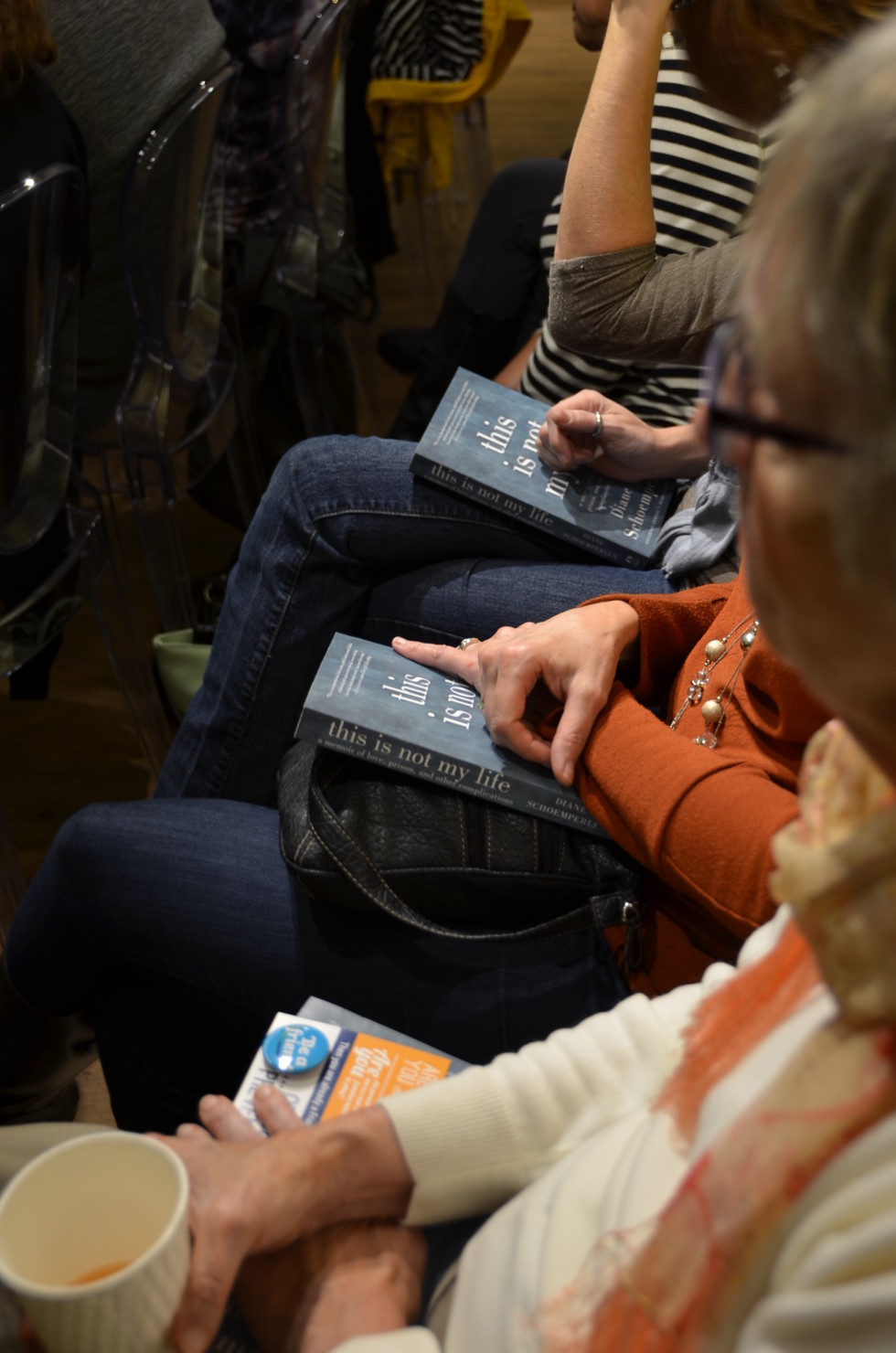
People came prepared! Many had read the book and had very insightful questions. Others came because of the topic, but bought the book by the end of the night!

In addition to a talk and reading by Diane, we invited additional panel members from the community & beyond to complement the discussion of prisons, justice, stigma and relationships. From left: Mike Farwell, Moderator; Diane Schoemperlen, Author; Jen Hutton, Women’s Crisis Services Waterloo Region, Shannon Moroney, Author of Through the Glass; Chris Cowie, ED Community Justice Initiatives
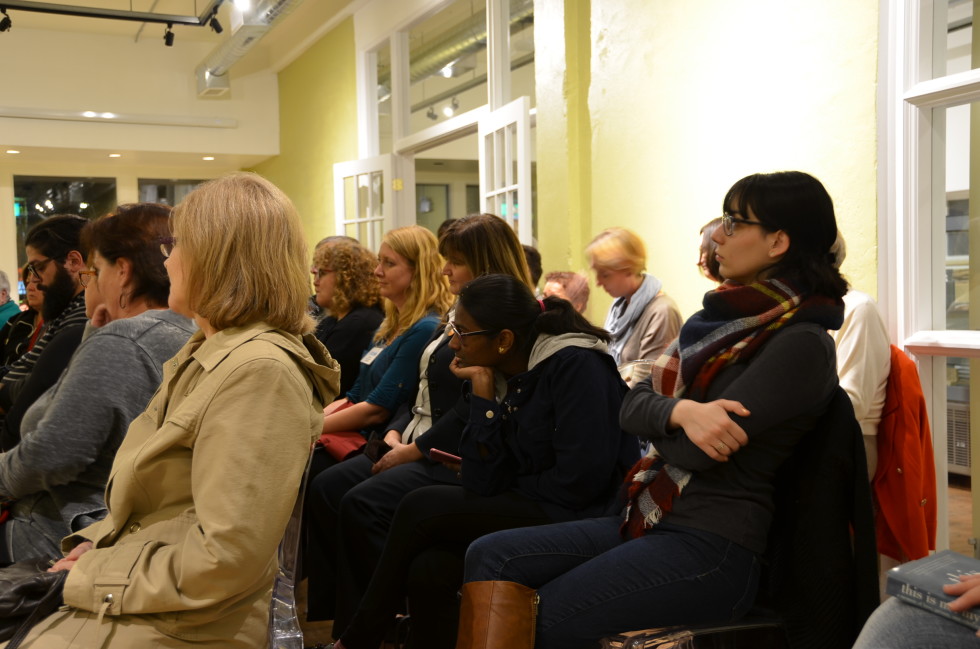
A very intent and listening audience!
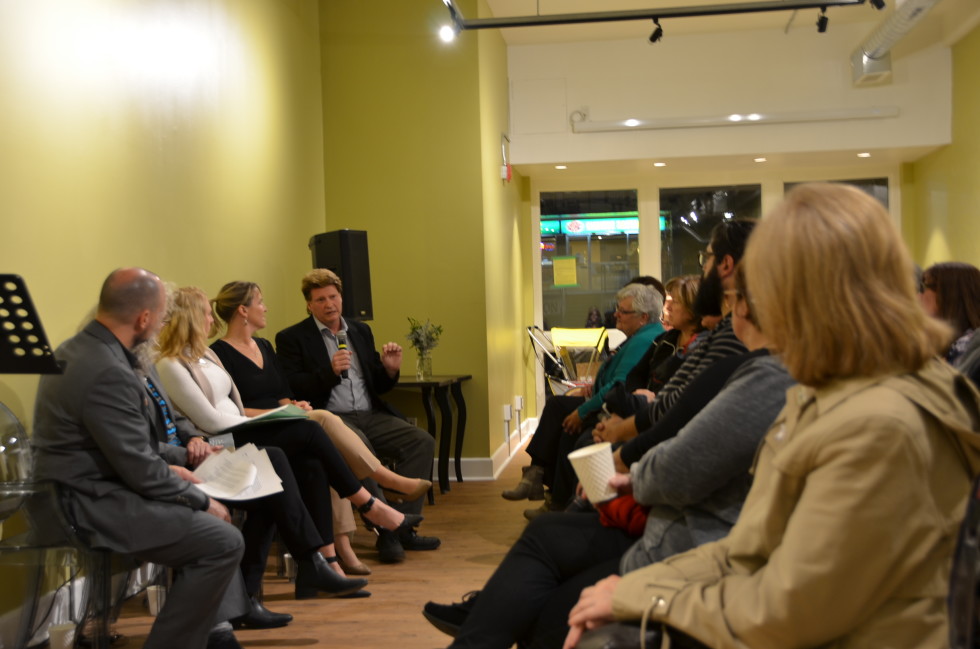
Chris Cowie from Community Justice Initiatives shared about the agency’s Restorative Justice mandate and how a more restorative process in prisons could help in countless ways i.e. better integration into society upon release, deeper understanding of the nature of offending, development of new skills to deal with conflict. Teaching and using restorative justice early can also be a prevention tool.
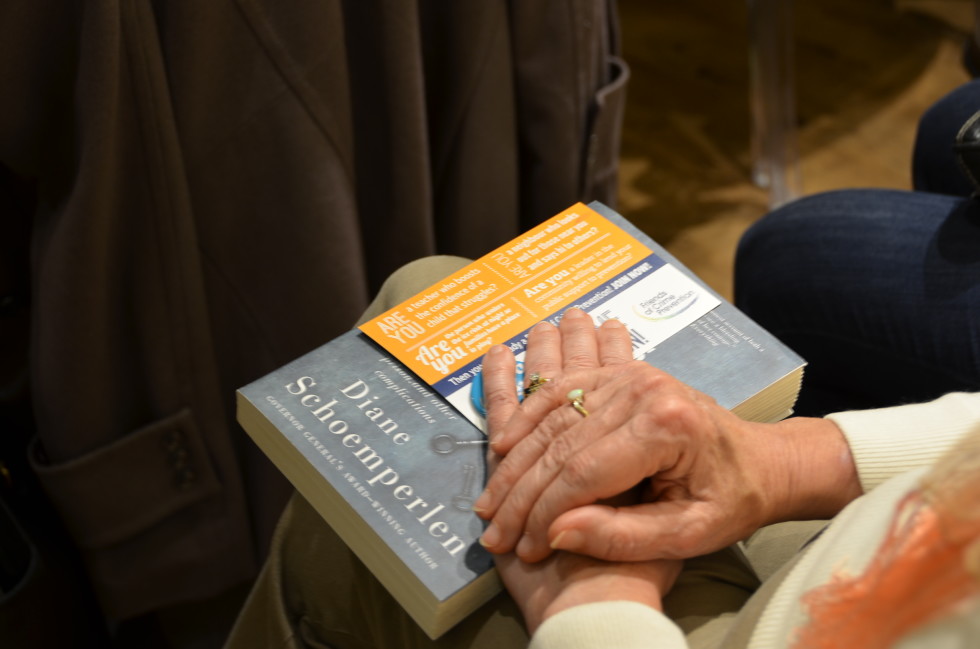
With all the new faces in the audience, it was a great opportunity for many to learn about w hat it means to be a Friend of Crime Prevention!

It only take a few minutes to become a Friend of Crime Prevention – just like Jen Hutton!
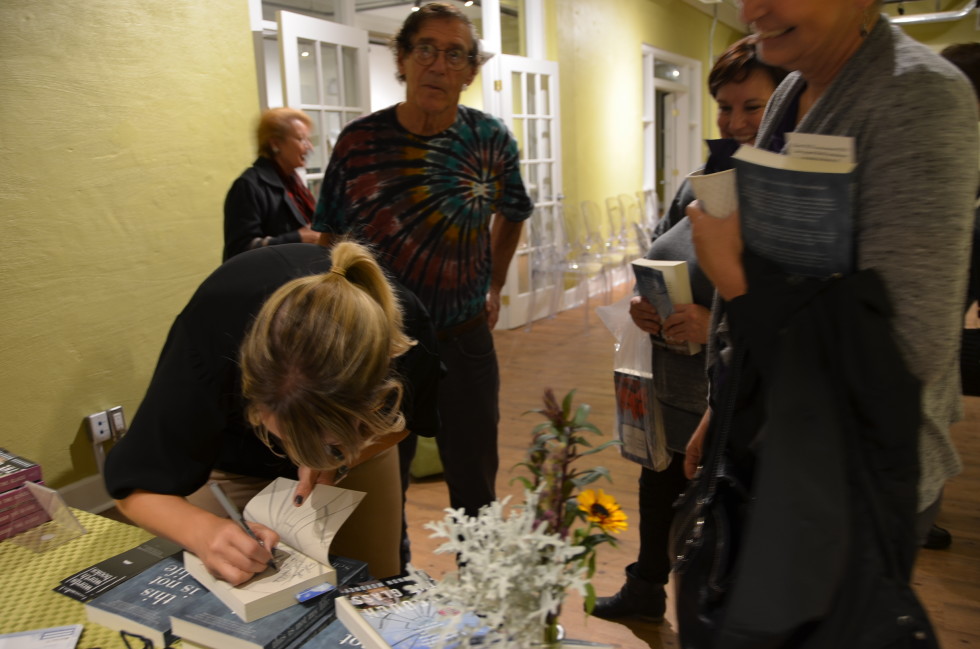
Both Diane and Shannon took time to sign books for anyone who wanted. Also a chance for great conversations.
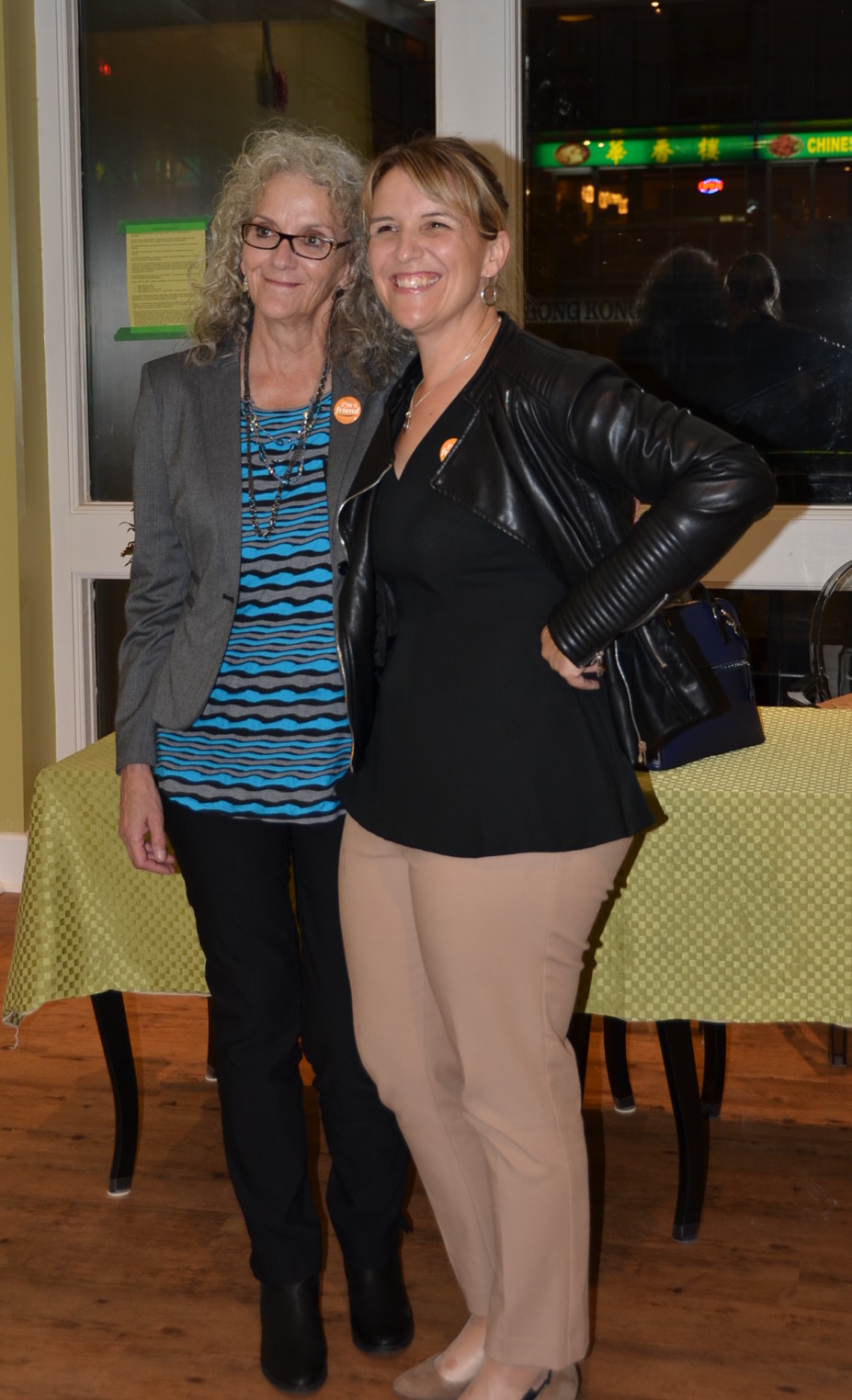
Diane and Shannon proudly display their “I am a Friend” buttons. Diane and Shannon were made honorary Friends and join Howard Sapers and Sir Neville, a guide dog, as Honorary Friends of Crime Prevention.
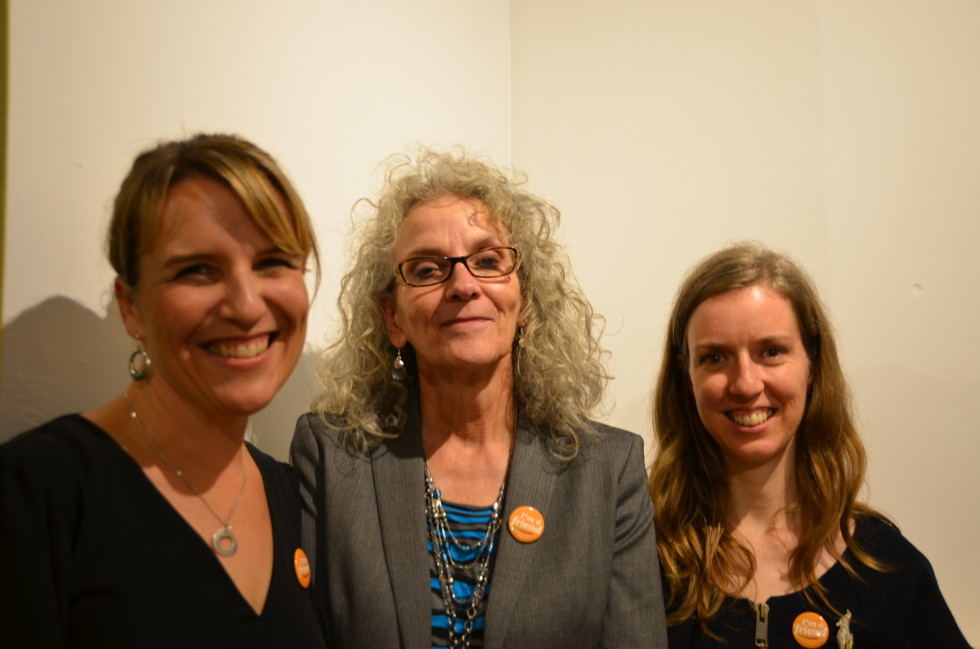
It was very special to have Shannon and Dianne together in the same evening. Shannon acted as a mentor to Diane during the writing of This is Not My Life. Shannon wrote her book Through the Glass about the life upheaval after husband confessed to the sexual assault and kidnapping of two women. Both Diane and Shannon have rich stories from which our community can learn so much! Diane and Shannon are pictured with Sarah Anderson, event organizer and facilitator from the Crime Prevention Council.
Posted on: February 4th, 2016 by Waterloo Region Crime Prevention Council
Our new strategic plan – Smart on Crime 2015-2018 – is now available!
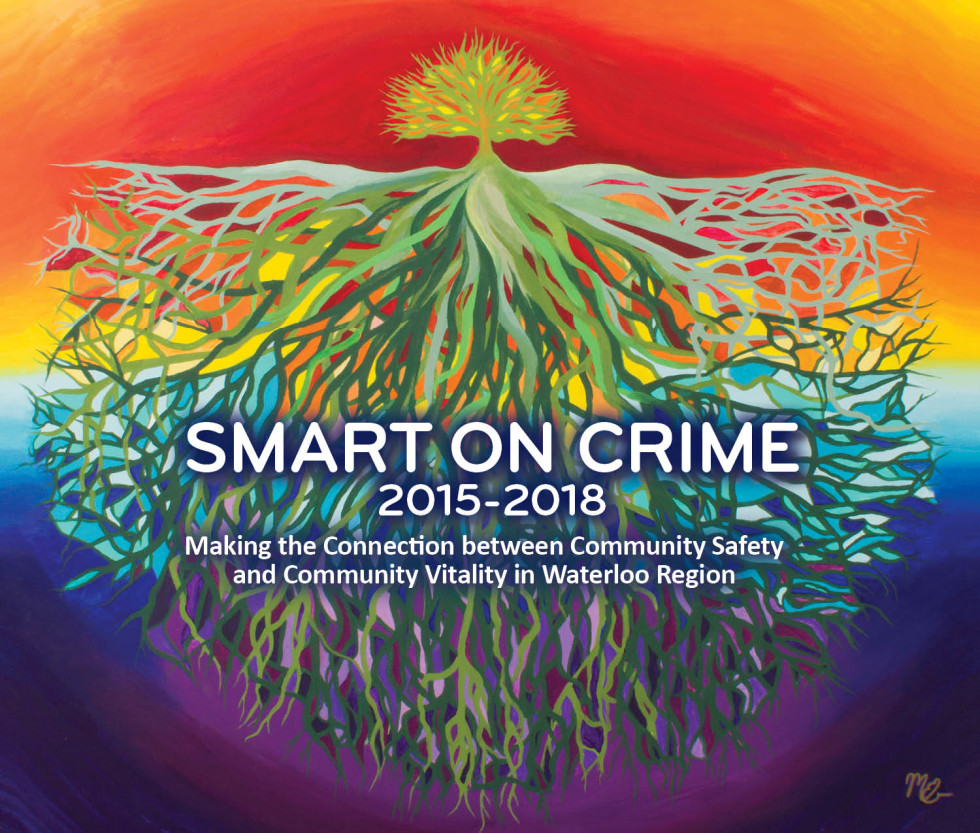
In 2015 we consulted with nearly 1,500 people in Waterloo Region, including the Friends of Crime Prevention, through telephone and online surveys and focus groups to help us navigate our road ahead. Thanks to all of you who participated.
What we heard was a resounding general understanding of root causes of crime. We are encouraged by the idea that the community understands why crime happens and how it can be prevented. This translates into many local actions that will contribute to community safety and vitality. The full data is captured in the report “Root Causes of Crime in Waterloo Region Consultation Report” available on our website.
Over the next four years, the Crime Prevention Council will focus its efforts in three key areas:
- Youth
- Neighbourhoods
- Building the momentum for Smart on Crime
We hope to do this work alongside our Friends of Crime Prevention and many other individuals and community partners.
Details of the plan are available online at www.smartoncrime.ca.
Posted on: November 3rd, 2015 by Waterloo Region Crime Prevention Council
 As we put the finishing touches on the Friends of Crime Prevention Human Library event, we wanted to share some of the human ‘books’ and ‘library subjects’ you will find that day! Such a rich diversity of experience, knowledge and community change! You will have to use your time wisely to visit even three of these fantastic books.
As we put the finishing touches on the Friends of Crime Prevention Human Library event, we wanted to share some of the human ‘books’ and ‘library subjects’ you will find that day! Such a rich diversity of experience, knowledge and community change! You will have to use your time wisely to visit even three of these fantastic books.
On poverty/inequality:
On problematic substance use:
On neighbourhood environments:
On family environments:
On mental health:
On housing:
On youth support & engagement:
What a collection!
Friday November 13, 2015
School of Social Work, Lyle Hallman Building
120 Duke Street West, Kitchener
(paid parking available at Kitchener City Hall. Entrance on Young Street, just across the street from the School of Social Work)
9:00 – 11:30 a.m.
Join us at 8:30 a.m. for our famous coffee social!
Posted on: September 16th, 2015 by Waterloo Region Crime Prevention Council
One of the most anticipated highlights of our year happened last week. In case you happened to miss it (?!) – although, I’m not sure how you could – Howard Sapers was in town. Yes, THE Howard Sapers. Federal Correctional Investigator for Canada and ombudsman for federally sentenced offenders.
We partnered with Kitchener Public Library as part of their new 85 Queen Speaker Series to host this event and filled the auditorium with 230 people from our community. The action packed evening included a screening of the film “State of Incarceration”, a keynote address by Howard Sapers and a panel discussion with community members, including a formerly incarcerated woman from Grand Valley Institution for Women.
-
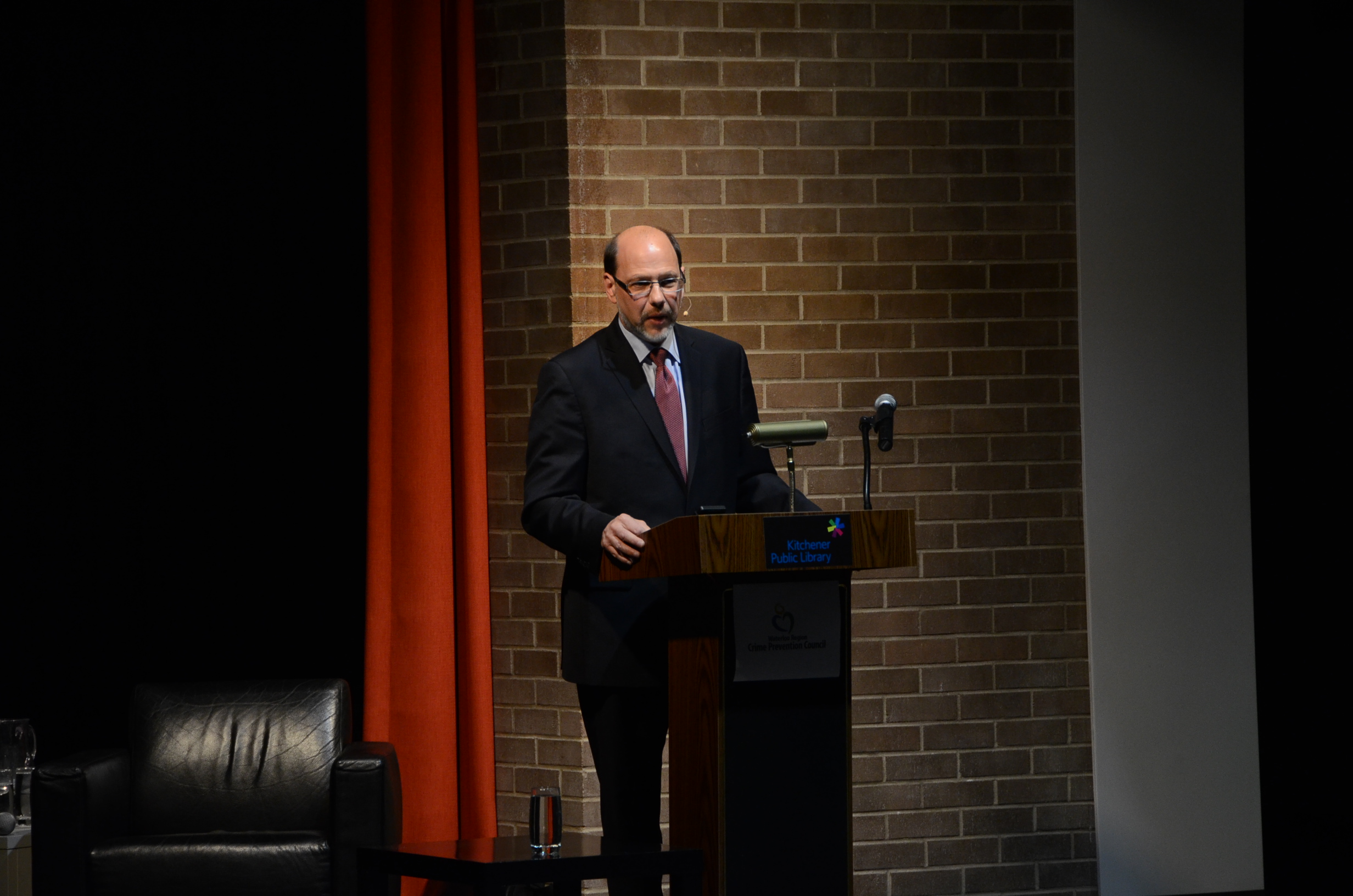
-
Howard Sapers oversees the Office of the Correctional Investigator, serving as an ombudsman for federally sentenced offenders.
-
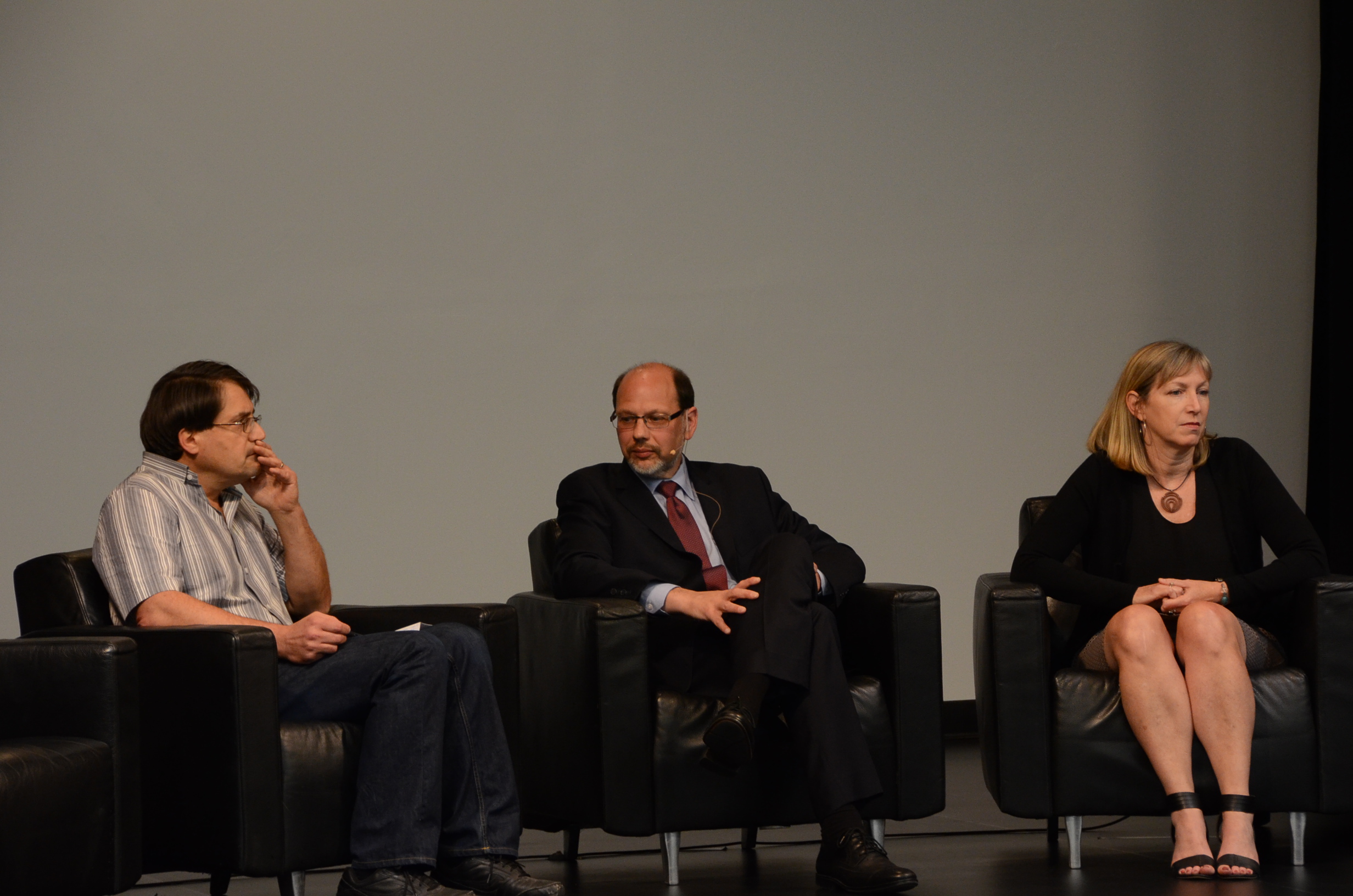
-
Panel with (from left) Chris Cowie from Community Justice Initiatives, (off camera) Joe Mancini from the Working Centre, Howard Sapers, Julie Thompson from CJI, and Dionne, (not seen, pseudonym), a former federal inmate.
-
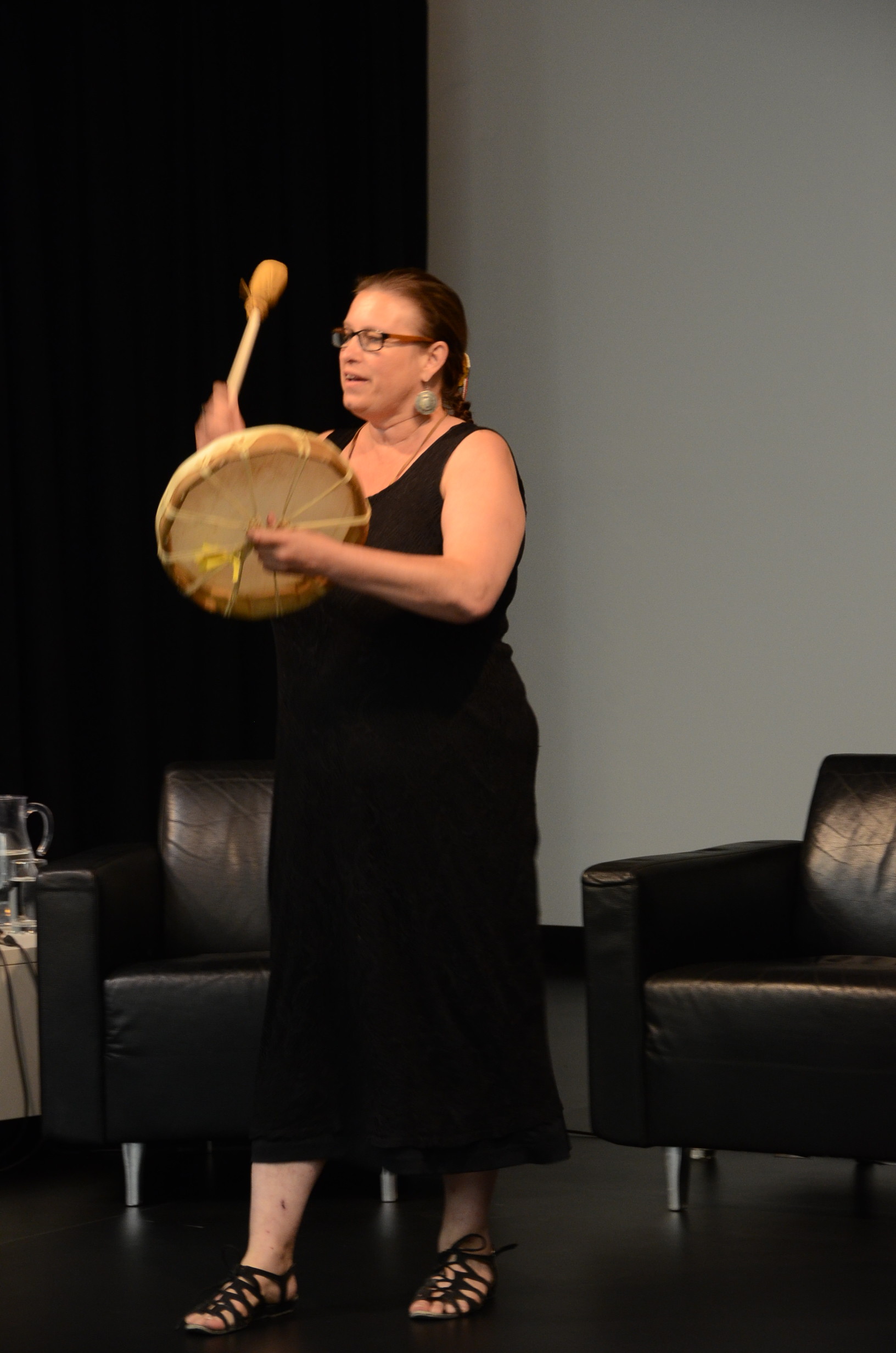
-
Aboriginal drummer Heather Majuary closed the event with drumming in honour of incarcerated Aboriginal lands.
-
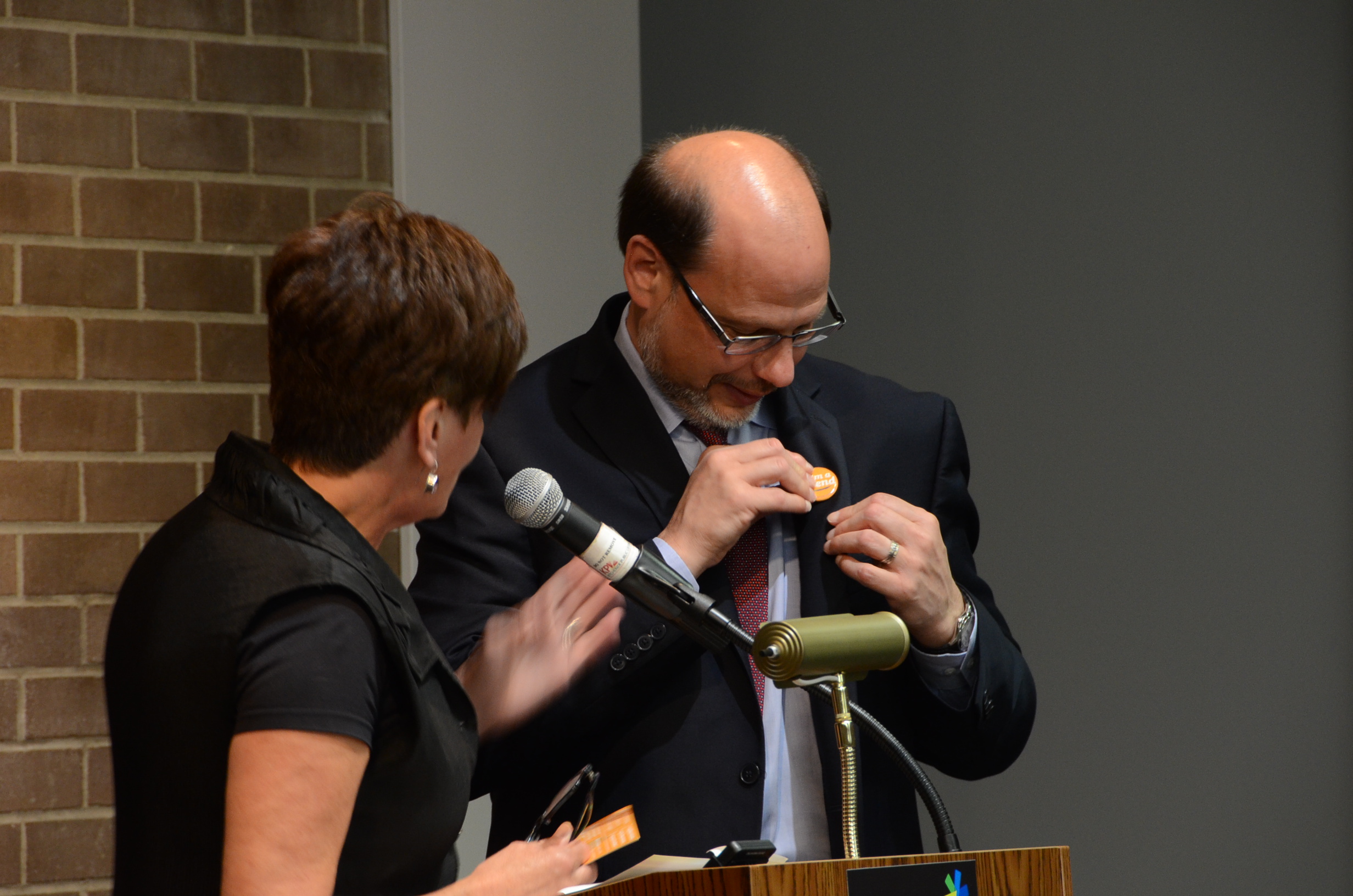
-
Howard Sapers becomes our first honourary Friend of Crime Prevention!
-

-
Howard Sapers chats with an attendee who is currently a minimum security inmate. [Source: Kitchener Public Library]
-
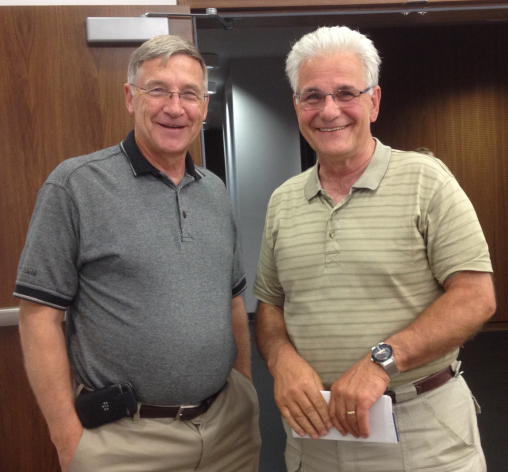
-
Regional Chair Ken Seiling with former parole officer Mark Yantzi, a pioneer in the field of restorative justice and past Executive Director of Community Justice Initiatives [Source: Kitchener Public Library]
-
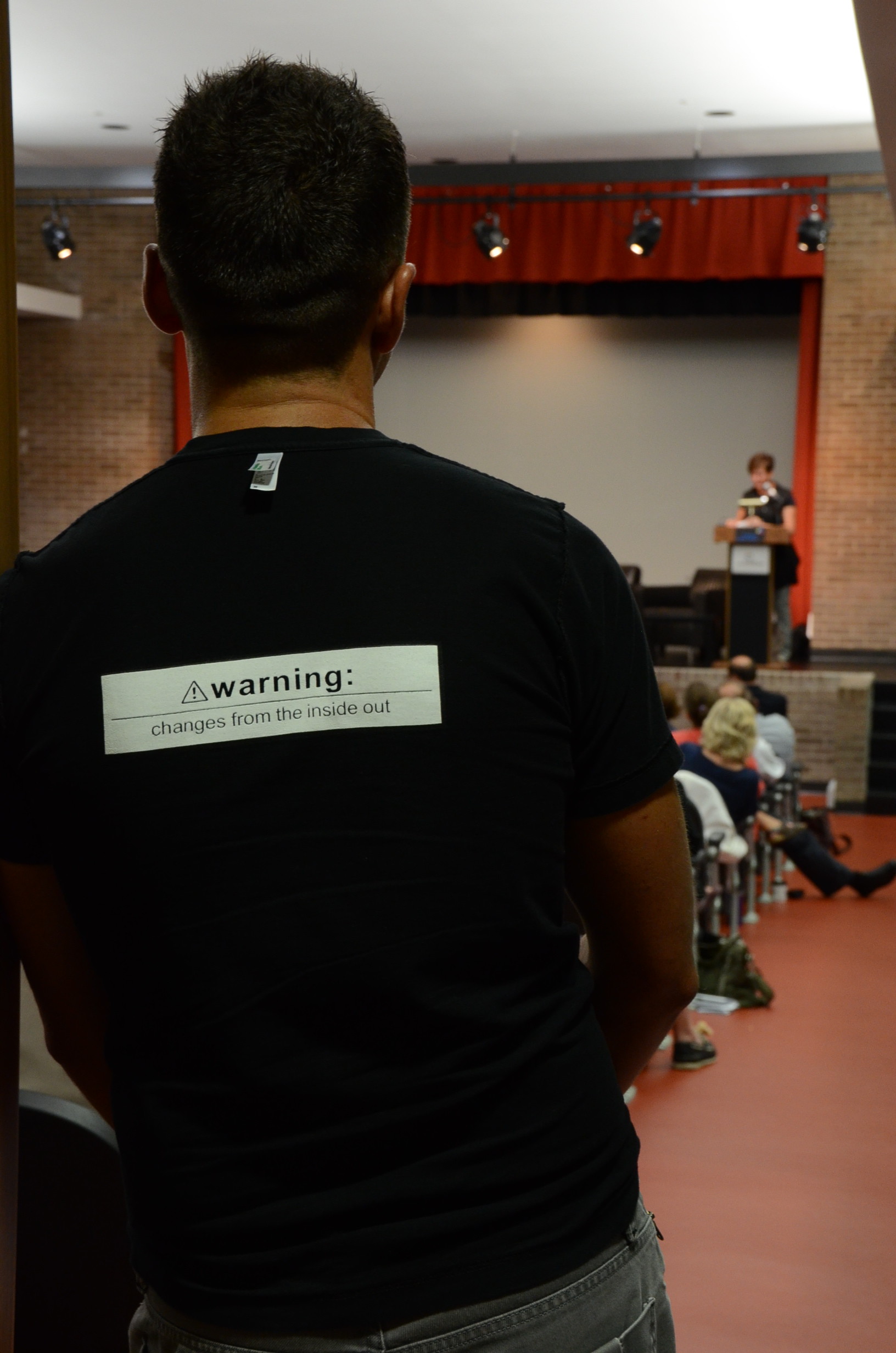
-
It’s true, change really does start from the inside. And that’s what Friends of Crime Prevention events are all about!
-
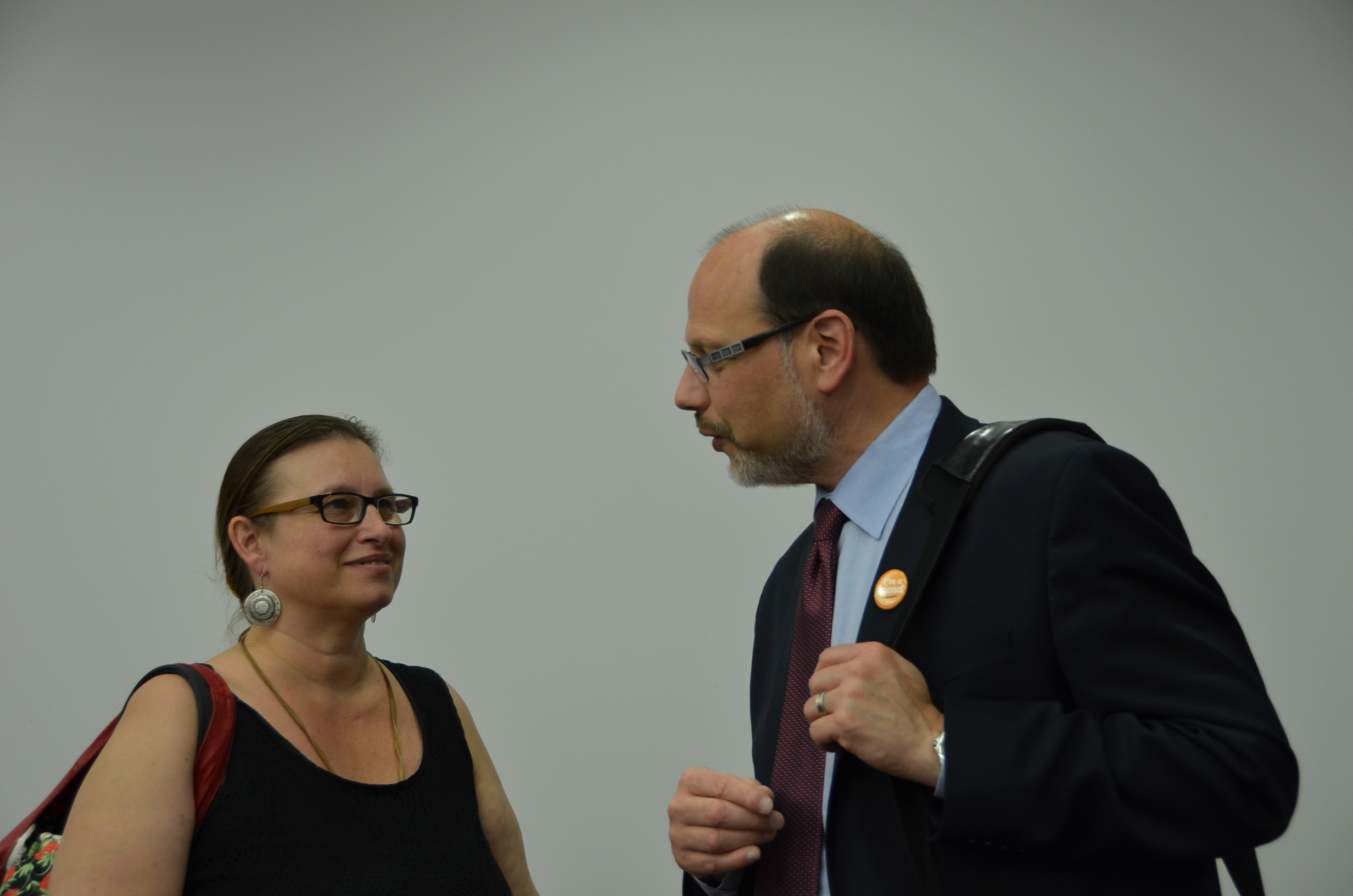
-
Howard Sapers chats with Aboriginal drummer Heather Majuary, who closed the event with drumming in honour of incarcerated Aboriginal lands
We have a video coming soon of Mr. Sapers’ keynote talk, but in the meantime, you can read his presentation here to catch all the incredible stats and stories he shared that night. He really does effectively paint a vivid picture about the state of Canadian prisons in 2015.
While you wait impatiently for the video, I”ll leave you with these two reflections from two currently incarcerated women from Grand Valley Institution for Women who attend the event. You’ll understand why it was such a big night.
Julie writes:
“I attended the forum for Friends of Crime Prevention, on September 10, 2015. I cannot begin to tell you how refreshing it is that discussions such as this are taking place. I was both shocked and pleasantly surprised at the amount of progressive people who attended the forum. There are faces and lives associated with the disturbing statistics Mr. Saper spoke of – mine is one of them. I was one of two currently incarcerated women at the event, with the Walls to Bridges Collective. Too often incarcerated people are treated as the rejects of society, disposable even, and let’s face it – advocating for us is not at the top of almost all priority lists. I firmly believe that many incarcerated people would not be in the criminal justice system to begin with, if they had been afforded access to and utilized stronger and earlier preventative measures through social intervention and more accessible social and health services; myself included. Sadly, I did not consider the flaws in our systems until I was directly affected. Now that I am, however, I cannot turn a blind eye to them anymore, not just for myself, but for the staggering amount of other people making up those statistics, and for those yet to come. I am relieved to know I am not alone in this quest. All human life has value – thank you for making “out of sight” not be “out of mind” anymore. The forum helped to humanize us and highlight some of the injustices of our daily reality. I left with a renewed sense of hope and purpose. I am thankful that this forum created a safe place for people to come together, ask questions, and push boundaries. To evoke much needed change will require more bridges to be built than walls. We have a long way to go, but I am hopeful that just as a storm starts with a single raindrop, so too does change start with forums such as this one.”
Denise writes:
Just as the world will always remember September 11, 2001, in a negative light, Thursday, September 10, 2015 will be etched in my mind for as long as I exist as an achievement to social awareness. You see, since my incarceration it was the only day in which I came in contact with people besides volunteers and members of the Walls to Bridges group and voice my dilemma while feeling safe to bare my soul. Mr. Howard Sapers provided statistics that were both daunting and hopeful. Information on how tax dollars are truly spent to build and house a growing prison population at a time where the crime rate for the past decade plus has been on the decline. I am part of those statistics and Canada is following the footsteps of the failed American system that ex President Bill Clinton and present sitting President Barak Obama stated ‘is not working’. The large majority of incarcerated people will be released and upon their discharge, are expected to function and contribute to the same society that deemed them as criminals. If education is at least a gateway to success, incarcerated people need more training to learn and utilize skills and tools required to help them successfully add to the fabric of society’s fast paced, ever changing existence. Prevention, Prisons & Popcorn at Kitchen Public Library was a forum that brought together a community of progressive thinking people aware of the challenges society will surely be faced with once the voiceless, faceless people are unconstrained. An awareness of prisons and the need for community inclusion upon the release of prisoners are part of an encompassing subject tax payers don’t realize every member of a community may be accountable for. After someone goes from inmate to civilian because they have paid their dues to a faulty justice system and they no longer live in the past where they made poor choices, when do they get a fair shot at being seen in a new light? There needs to be more discussions such as the one Prevention, Prisons & Popcorn opened up where communities are aware of their interconnectedness to their surroundings, even their walled surroundings.
Yep, it was that kind of night.
Posted on: April 7th, 2015 by Waterloo Region Crime Prevention Council
Back in February 2015, the Church Council on Justice and Corrections (CCJC), released a very promising evaluation report on the Circles of Support and Accountability (CoSA) program that operates across Canada. CoSA is a “community-based reintegration program, grounded in restorative justice principles, that holds sex offenders accountable for the harm they have caused while assisting with their task of re-entry into communities at the end of their sentences”.
The evaluation, the first of its kind in Canada, gives an in depth description of how the program works, documenting it’s success rate and cost savings due to reduced recidivism and reoffending. In short, the evaluation says that this program works.
Great news!
But then, on March 2nd 2015, it was announced that as of March 31, 2015, Correctional Services Canada (CSC) would not renew the funding it has been providing since 1996, as a partner to CoSA. The program has additional partners in numerous Canadian cities such as the Mennonite Central Committee Ontario (MCCO) for the program operated in Kitchener, Hamilton and Toronto. MCCO has funding from CSC until March 31, 2018.
CoSA Canada quickly released a statement to clarify and restate the real impacts of this program: a proven model that addresses a high risk crime against vulnerable people in a humane and accountable way and shows that it can reduce recidivism of the highest risk sexual offenders by 70 – 83%.
This is what we at the Crime Prevention Council would be inclined to call a “smart on crime” approach to reducing crime and victimization:
- the program is based in good evidence,
- the approach is measured and documented in similar ways across programs,
- it has produced excellent results,
- it is proven to reduce and prevent further crimes at a lower cost than keeping an individual incarcerated for “life”, and,
- helps to reintegrate individuals into our community, which is where 95% of people exiting prison, including those convicted of sexual offenses, will return eventually at the end of their sentences
Meanwhile, this ‘made in Canada’ approach has been successfully exported to a number of jurisdictions in the U.S. and the U.K., in addition to France, The Netherlands, Italy, Australia, New Zealand, Latvia and South Korea.
When programs show that they accomplish what they set out to do at comparatively low investment and provide a high return on investment to the safety of our community, their sustainability is not only vital, but smart and it makes so much more sense to support of them rather than cut them.
As such, the decision by CSC to cut funding for CoSA is tough to understand and needs further dialogue and consideration.
Posted on: March 25th, 2015 by Smart on Crime
Never have I seen such a beautiful collection of voices, all unique, and yet all singing the same tune. The Everyday: Freedom from Gendered Violence Symposium put on by the Social Innovation Research Group, and brilliantly detailed by Jay Harrison here, was a phenomenal representation of the intersection of research, arts, and community work. While the Symposium had a particular focus on the university experience, its messages are equally applicable in our neighbourhoods and communities as we think about crime prevention and smart approaches to the gendered violence that occurs in those spaces.
I don’t think I could ever do justice to the amazing topics that were discussed – responding to disclosure, the particular experiences of gendered violence faced by racialized and LGBTQ students, engaging men in prevention, and more. So, I thought the best way was to provide some insight from the speakers themselves:
“What does it mean to be safe?” –Dr. Jenn Root
I sat and thought, ‘good question!’ How can we talk about safety without first talking about what that means? Discussions of violence and crime prevention should always start at the roots.
“Public space is not equal for everyone.” –Tatyana Fazlalizadeh
This rang true for me. How many times have I called a friend or family member to pick me up because I didn’t want to walk alone?
“Did that really just happen?” –Dr. Michael Woodford
Dr. Woodford was speaking about the slurs and comments made to LGBTQ students. But for me, I was struck by the thought of how often we doubt ourselves, as well as our friends and our families when they tell us about something seemingly “minor” is said to them: ‘Oh come on, it’s not so bad…’
“Street Harassment is abuse.” –Tatyana Fazlalizadeh
Tatyana amazed me with this beautiful comparison of street harassment to domestic violence: if a man was yelling derogatory names at his wife, we would call it abuse. When women have cat-calls yelled at them from across the street, however, we tend to brush it off and ignore it.
“The kind of terrorism I want to talk about in this country is domestic violence.” –Judah Oudshoorn
While the media and our governments continue to feed us horrible stories of the atrocities occurring under the umbrella of terrorism, sometimes we forget about the atrocities happening much closer to home – maybe in our homes, maybe in our neighbour’s home.
“Sexual violence is a strategy of war – it is not just against the women, but also the community – it is an attempt to demoralize the community.” –Dr. Eliana Suarez
At the Crime Prevention Council, we often talk about the role of community as a building block for crime prevention. If sexual violence is designed to demoralize a community, then we, as that community, must take a leading role in preventing it.
“Either you’re violent, silent, or creating meaningful change. And if you’re silent, you’re violent.” –Judah Oudshoorn
What a powerful statement. I know which role I choose to play.
“Women are not just resilient, they are resistant – they attempt to change their circumstance.” –Dr. Eliana Suarez
“Maybe there is more than one way to be a man.” –Stephen Soucie
I felt these two quotes belonged together. Discussions around gendered violence often leave me feeling sad and hopeless. But these two spoke of hope, optimism, and change for both men and women.
“It is easier to build stronger children than to fix broken men.” –Stephen Soucie
Again, I felt another ray of hope. Through my research at the Crime Prevention Council, I have learned that early interventions have astonishing success in reducing rates of crime. This is where I think we should be investing our time, energy, and dollars.
“Compliance is important, but compassion is more important.” –David McMurray
An important reminder to wrap things up: while being “tough on crime” continues to get lots of media attention, we would be wise to look at the evidence base and the fact that the majority of “tough on crime” approaches do nothing to reduce crime. Early intervention, prevention that is proven to work, and renewed focus on humane approaches to rehabilitation and reintegration, would go much further toward reducing incidents of crime and victimization.
There were a myriad of other speakers who had insightful comments, but unfortunately, I am only able to present a small portion here. The passion in the room from each and every speaker was evident – from the researchers to the artists to the community workers. They all shared with us their struggles, and yet I came out the other side feeling hopeful and fulfilled. If they can commit themselves to this struggle, they must feel that it is important and that change can be made. As I move forward in working on my Master of Social Work thesis next year, which touches on this topic, I feel like maybe I can contribute a small portion to this struggle. Maybe, someday, we could live in a world where everyday, we were free from gendered violence.
“The struggle is real… the struggle continues” –Janice Lee
How are YOU contributing to the struggle?

Eleanor McGrath
Author: Eleanor is a Master of Social Work student at Wilfrid Laurier University. She is completing her first placement at the Waterloo Region Crime Prevention Council, working on a narrative literature review of how crime mapping can be used to implement community-based prevention initiatives. Her favourite hobbies are laughing, rock climbing, and travelling.
Posted on: December 30th, 2014 by Waterloo Region Crime Prevention Council
We’ve been in reflection mode this week at the WRCPC office. The time of year lends itself perfectly to this kind of ‘look back’ at the year that was 2014. I hope you are enjoying your own reflections. And, since we’re at it, why don’t we do some reflecting together, with the help of Smart on Crime.
We had such a variety of blog posts this year, ranging from what we were reading to crime stats, to special posts from Friends of Crime Prevention. Early in 2014, we wrapped up a year long examination of the root causes of crime. With the end of inREACH in Waterloo Region, we took some time to share what our community has learned from inREACH and engage our community in a follow up event in April where planned next steps. We even introduced you to some new words to enrich your vocabulary! And of course, we couldn’t help but challenge our community with some harder hitting posts.
Our readers are as diverse as our blog posts, which would explain the diversity of popular blogs this year. Here’s the round up of our top 14 posts from 2014.
- Public Opinion & Crime – Anthony Piscitelli
“Since 2006 the Canadian government has focused on being tough on crime. The policy approach continues to this day but it seems the Canadian public is starting to see these changes as a policy excess. Instead of focusing on punishment, public opinion polls suggest the government focus should be on prevention through education and social development programs.”
- Trent’s Trajectory: The dollars and $ense of crime prevention
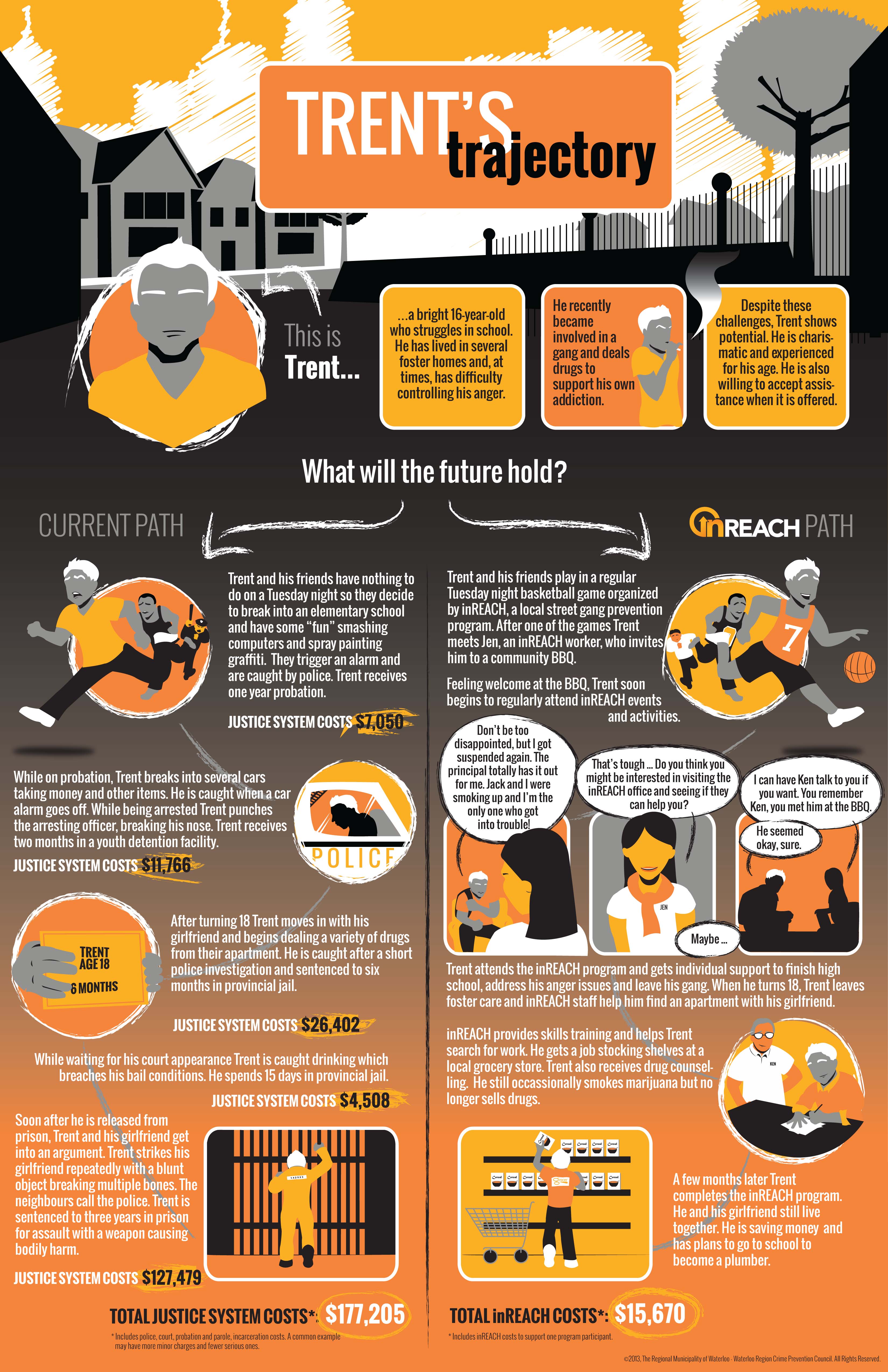
- A new story is needed – guest post by Friend of Crime Prevention, Doug McKlusky
“As a Friend of Crime Prevention, I believe that that the heart of crime prevention is through social and community development…..
Imagine neighbourhoods where everyone feels a sense of belonging, where inclusion trumps fear.
Imagine workplaces where people belong, and where respect and collaboration trump power and politics.
Imagine schools where belonging trumps bullying and streaming.”
- The new story continues…. – guest post by Friend of Crime Prevention, Doug McKlusky
“I do believe that many small actions will add up to a large action on the road to building a community of belonging. It can be as simple as acknowledging the presence of a homeless person in downtown Kitchener, they are part of our community, a friendly smile goes a long way in making a person feel like they belong. I challenge you to do something to make our community a community of belonging, smile at a stranger, volunteer somewhere in your community, it will make a difference, it will connect you!”
- Inspired by inREACH: Reflections of a youth outreach worker – Youth Outreach Worker, Krista McCann
“inREACH fostered a working environment that not only allowed us, but encouraged us to work outside of the box. I’d be lying to say the task was not daunting at first. In my previous experience working as a Youth Worker I had never been given such flexibility and confidence within a position to achieve the desired outcome; an outcome that was not based on the amount of programs ran or number of program participants but the ability to engage youth in their community.”
- Neighbourhood policing: A learning opportunity for Friends of Crime Prevention – WRCPC Student, Ryan Maharaj
“To usher in 2014, WRCPC hosted a learning event on ‘Neighbourhood Policing’. Naturally, Friends of Crime Prevention & WRCPC have a common interest with the police on all things related to crime prevention, community safety and well-being. Inspector Kevin Thaler from the Waterloo Regional Police Service was our guest to unveil the recent sweeping changes to their organizational structure, daily operations and dispatch methods. The results are what is now known as Neighbourhood Policing.”
- Between life and death: Responding to drug overdoses in Canada – former WRCPC student, Kayla Follet
This article appeared in the July 14, 2014 edition of the Waterloo Region Record.
- By the numbers: Wading through police-reported crime statistics 2013 – Anthony Piscitelli
“Statistics Canada released their annual Police-reported crime statistics 2013 report in July (and in French). There is always so much to sift through and interpret. Learn more from the Canadian Criminal Justice Association.”
- By the numbers: Hate crimes in Waterloo Region – Anthony Piscitelli
“In 2009, the Kitchener-Cambridge-Waterloo census metropolitan area (CMA) had the highest hate crime rate in Canada, according to police reported statistics. Did you catch the end of that sentence? “…..according to police reported statistics”. It might seem insignificant, but it might be the key to understanding why the 2009 hate crime rate in Waterloo Region is so high compared to other CMAs in Canada. “
- No clichés: A reflection on working with the youth of inREACH – guest post by Karl Garner
“Having been with inREACH, it became quite evident, that the youth we worked with often experienced clichés in their lives. They were labeled, stereotyped, and their behaviours were often predicted by the adult world around them, yet most of the time no one knew anything about them. Outside of where they lived, or who they hung out with, or the school they went to, or perhaps what they look like, do many even know these youth? The label which is the umbrella they live under is their cliché.”
- Ignoring what we’ve learned. Or, how to ensure street gangs become a real problem in Waterloo Region – Ryan Maharaj
“It’s easy to assume that we should apply what we’ve learned from the inREACH project to better support marginalized youth in our community. But have you every stopped to wonder, what happens if we ignore what we’ve learned? What if we shed the rose-coloured glasses and donned the shades of pessimism to see the barriers that stand in our way? What if we tried to see the glass half empty? How can we make a problem like street gangs in Waterloo Region, worse?”
- The community weighs in on the root causes of crime: change and action – Dianne Heise
“How do we get at the root causes of crime and prevent it from happening in the first place?
This isn’t a direct, straight answer, but, the Waterloo Region Crime Prevention Council believes part of the solution is to monitor the root causes of crime over time. Then we, as a community, can better understand and address the social, community and economic conditions associated with crime and victimization. Check out the Waterloo Region Crime Prevention Council’s report – A Snapshot in Time: The Root Causes of Crime in Waterloo Region to find out how we are doing in early childhood development, employment, community trust and other important indicators.”
….. and part 2 of The community weighs in on the root causes of crime: change and action
- Why communities need neighbourhood-based programming for youth – guest post by Courtney Didier, Alison Neighbourhood Community Centre
“We have worked with youth who have great dreams and aspirations for the future, but have trouble putting their vision into a workable plan. On the other side of the coin, we have worked with youth who have little to no confidence in their abilities, thus requiring a little more encouragement and a little more trial and error in determining what really gets them motivated and excited.”
- Lessons learned in a gang project – Dianne Heise and Rohan Thompson
“Gang Prevention Is…. a) addressing underlying issues, and, b) not about getting a kid to take off the bandana. We often heard – “we’ve got this kid, he’s in a gang – fix him.” So often in our case management and system navigation work, it wasn’t about getting this young person to take off his bandana or to stop hustling or whatever, we never approached the work in that fashion. But it was about the underlying issues and working on them. Mostly we were dealing with issues of poverty, untreated trauma, family breakdown, substance abuse, disengagement and lack of opportunities. These are the problems that young people and gang members and people in general are dealing with. We want to demystify that label of gang member that says their needs are different than any other groups. These same issues are the drivers behind the behaviours.”
So many great reads from 2014. But if you’re in the mood for something to watch, rather than read, might I suggest our newest video on Collaboration!
We look forward to bringing more great Smart on Crime blogs for you in 2015. Better yet, we love hearing your comments, reactions and responses to the posts and guest commentaries. We look forward to hearing more from you next year!
 All of the calls to action already mentioned in the previous blog posts (humanizing people in prison & advocating for programs that work) help to create and strengthen system change in big and small ways. The work of larger structural change is long term, often slow work: Not for the faint of heart, but everyone can still play a role.
All of the calls to action already mentioned in the previous blog posts (humanizing people in prison & advocating for programs that work) help to create and strengthen system change in big and small ways. The work of larger structural change is long term, often slow work: Not for the faint of heart, but everyone can still play a role.





















 As we put the finishing touches on the
As we put the finishing touches on the 








